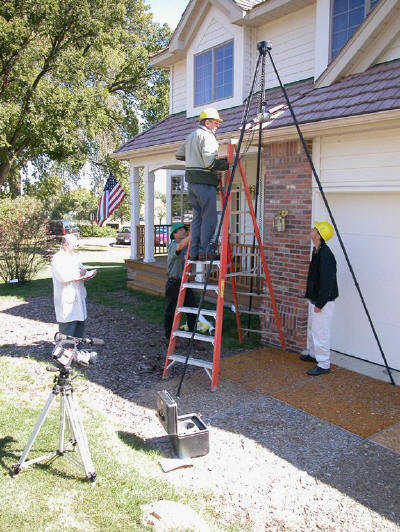Improved Engineered Wood Fiber (EWF) Surfaces for Accessible Playgrounds Field Performance Testing: Final Report II
Impact Annenuation [sic]
On September 24, 2002, a sunny day with a temperature of 15C, Doug Zeager and Ted Illjes from Zeager Brothers, Inc. came to FPL and performed the ASTM F-1292 testing on the eight experimental exterior surfaces. A tripod was erected to center the impactor over each surface (Figure 5). The results are summarized in Table 4.

Figure 5. A 4.5 kg (10 lb.) hemispherical impact head is shown installed over the D surface at a height of 3 meters (10 feet). The handheld instrumentation package is being held by Ted Illjes on the ladder and is connected to the impactor via the coiled wire. Doug Zeager awaits the impactor’s arrival and will catch it on its first rebound from the surface.
Table 4. Surface Impact Testing Results per ASTM F 1292:
Phase I surfaces (unaged) and Phase II (exposed for 6 months)
|
Surface/ Test |
Drop 2 G | Drop3G | Drop2 HIC | Drop 3 HIC | ||||
|---|---|---|---|---|---|---|---|---|
| Phase I | Phase II | Phase I | Phase II | Phase I | Phase II | Phase I | Phase II | |
| A2 | 52 | 72 | 57 | 71 | 244 | 275 | 272 | 265 |
| B | 53 | 81 | 62 | 79 | 213 | 308 | 251 | 320 |
| C | 67 | 139 | 62 | 130 | 332 | 825 | 315 | 740 |
| D | 68 | 109 | 63 | 109 | 350 | 564 | 357 | 541 |
| E2 | 68 | 83 | 76 | 81 | 274 | 285 | 307 | 306 |
| F | 55 | 85 | 54 | 90 | 236 | 339 | 248 | 387 |
| G | 56 | 83 | 60 | 87 | 312 | 313 | 324 | 318 |
| H | 65 | 103 | 69 | 101 | 325 | 493 | 406 | 472 |
The specification calls for a maximum deceleration G of 200. Considering the mode of falls on playgrounds, the maximum G was chosen for the playground application to balance the cost of the cushioning surface with the expectation for injury from falls. As a relative comparison it is useful to note that the standard test for motorcycle helmets requires the helmet to bring an instrumented headform to rest from 4.7- 5.6 m/s (11-13 miles per hour) without exceeding 400
G. We note that all the surfaces pass the existing specifications for impact attenuation of playground surfaces. The significant observation is that all the polyurethanes exhibited higher G values overall, in comparison to EWF, silicone and latex stabilized EWF. Only the polyurethanes exceeded 100, but none exceeded 140.
A similar observation can be made for the HIC. All the surfaces passed the existing HIC specifications, as it is not to exceed 1000. The HIC value of 1000 is generally presumed to correlate with the impact dynamics required to cause a brain concussion. Again, as a group, the polyurethanes, foaming and non-foaming had the highest HIC of all the surfaces tested. The minimum value was 472 and the highest reached 825. All the other surfaces ranged from 265 to 387. It is presumed that the HIC of 825 will result in a much higher percentage of fall injuries than will a surface with an HIC of 400.
A significant difference in behavior (Tukey tests, α=.10) differentiates the polyurethanes from the latex and silicone surfaces. The silicone, latex, and unstabilized EWF have statistically indistinguishable impact performance. We are able to state with confidence that the 6 months of aging have negatively changed the impact performance significantly for all systems except the unsurfaced EWF.

User Comments/Questions
Add Comment/Question